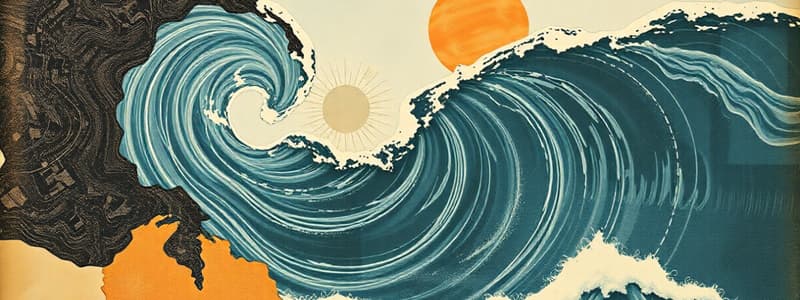Podcast
Questions and Answers
Which of the following statements best describes the primary cause of the Coriolis effect?
Which of the following statements best describes the primary cause of the Coriolis effect?
- Temperature gradients between the Equator and the poles.
- The gravitational pull of the moon on the Earth's atmosphere.
- Differences in water salinity across the Earth's oceans.
- The rotation of the Earth on its axis. (correct)
How does salinity affect the density of seawater, and subsequently, its movement?
How does salinity affect the density of seawater, and subsequently, its movement?
- Higher salinity increases density, causing the water to sink. (correct)
- Higher salinity decreases density, causing the water to sink.
- Higher salinity increases density, causing the water to rise.
- Salinity has no impact on density or water movement.
What is the driving force behind thermohaline circulation?
What is the driving force behind thermohaline circulation?
- Wind patterns and tidal forces.
- The Coriolis effect alone.
- Atmospheric pressure differences only.
- Changes in temperature and salinity. (correct)
How do land masses primarily influence surface ocean currents?
How do land masses primarily influence surface ocean currents?
How does the release of latent heat from cooling water masses impact regional climate, as exemplified by Great Britain?
How does the release of latent heat from cooling water masses impact regional climate, as exemplified by Great Britain?
What is the primary reason that melting ice sheets can weaken the Gulf Stream?
What is the primary reason that melting ice sheets can weaken the Gulf Stream?
Why does land tend to reflect heat, while water tends to absorb it?
Why does land tend to reflect heat, while water tends to absorb it?
Which of the following statements accurately describes the vertical movement of air and water masses due to temperature differences?
Which of the following statements accurately describes the vertical movement of air and water masses due to temperature differences?
Considering both the Coriolis effect and temperature differences, which direction would surface currents near the Equator predominantly move?
Considering both the Coriolis effect and temperature differences, which direction would surface currents near the Equator predominantly move?
What would be the most likely effect of a complete collapse of the Gulf Stream?
What would be the most likely effect of a complete collapse of the Gulf Stream?
If a body of water experiences increased evaporation near the Equator, how would this affect the density of the remaining surface water?
If a body of water experiences increased evaporation near the Equator, how would this affect the density of the remaining surface water?
How does the temperature of air masses change due to the presence of land or water?
How does the temperature of air masses change due to the presence of land or water?
How does the vertical air movement combine with lateral movement?
How does the vertical air movement combine with lateral movement?
What is the role of thermohaline circulation in Earth's climate system?
What is the role of thermohaline circulation in Earth's climate system?
What role does latent heat from the Gulf Stream play in regulating temperatures in Northwestern Europe?
What role does latent heat from the Gulf Stream play in regulating temperatures in Northwestern Europe?
Flashcards
Gulf Stream
Gulf Stream
A warm current flowing along the U.S. East Coast, warming Northwestern Europe.
Thermohaline Circulation
Thermohaline Circulation
Circulation driven by temperature and salinity differences; influences climate.
Land Mass Influence
Land Mass Influence
Continents deflect surface currents, altering flow patterns.
Air Convection
Air Convection
Signup and view all the flashcards
Land vs. Water Heating
Land vs. Water Heating
Signup and view all the flashcards
Ice Melt Impact
Ice Melt Impact
Signup and view all the flashcards
Gulf Stream Collapse Effects
Gulf Stream Collapse Effects
Signup and view all the flashcards
Circulation
Circulation
Signup and view all the flashcards
Coriolis Effect
Coriolis Effect
Signup and view all the flashcards
Rising and Sinking Fluids
Rising and Sinking Fluids
Signup and view all the flashcards
Circulating Air Cells
Circulating Air Cells
Signup and view all the flashcards
Sea Water Salinity
Sea Water Salinity
Signup and view all the flashcards
Latent Heat
Latent Heat
Signup and view all the flashcards
Impact of Latent Heat
Impact of Latent Heat
Signup and view all the flashcards
Study Notes
- Earth's surface is covered in fluids (air and water) separated by density.
- Dense, cold waters are at the bottom, while thin, light air masses are at the top.
- Circulation is the movement of air and water driven by various variables.
The Coriolis Effect
- The Coriolis Effect is the deflection of air due to Earth's rotation.
- As Earth rotates east, air is pulled along but slower than the planet.
- Air appears to move westward along the Equator, changing direction in different latitudes.
- The Coriolis effect also affects ocean surface currents, deflecting them similarly along the Equator and creating westward surface currents.
Rising and Sinking
- Air and water also move vertically due to temperature differences, with warm fluids rising and cool fluids sinking.
- Vertical and lateral air movement creates circulating air cells, resulting in consistent wind patterns.
- Fluid composition affects density: higher seawater salinity increases density.
- Thermohaline circulation is a system of currents driven by temperature ("thermo") and salinity ("haline") changes causing vertical water movement.
- At the Equator, surface water evaporation increases salinity, altering water density.
- Warm currents moving towards the poles cool and sink, releasing latent heat and impacting the climate of nearby land masses.
- Great Britain's temperate climate is due to the warm Gulf Stream current, which cools and sinks in the North Atlantic, releasing latent heat.
- Changes in thermohaline circulation have historically caused rapid and extreme climate changes.
Land
- Land masses (continents) deflect surface currents.
- Land reflects heat differently than water absorbs heat.
- Air masses rise and sink with temperature changes caused by land or water.
- Glider pilots use updrafts over warm land and downdrafts over cool water.
Ocean Circulation and Climate Change
- The Gulf Stream affects the climate of the southeastern United States and western Europe.
- Warm water from the Gulf of Mexico travels to the North Atlantic, cools and sinks, then moves south through the South Atlantic.
- Melting ice sheets and ocean warming are adding less dense freshwater to oceans.
- This change is making it harder for water to sink, weakening the Gulf Stream.
- Potential Gulf Stream collapse could cause sea level rise (e.g., in Miami) and increase storms and temperatures in Western Europe.
Studying That Suits You
Use AI to generate personalized quizzes and flashcards to suit your learning preferences.




